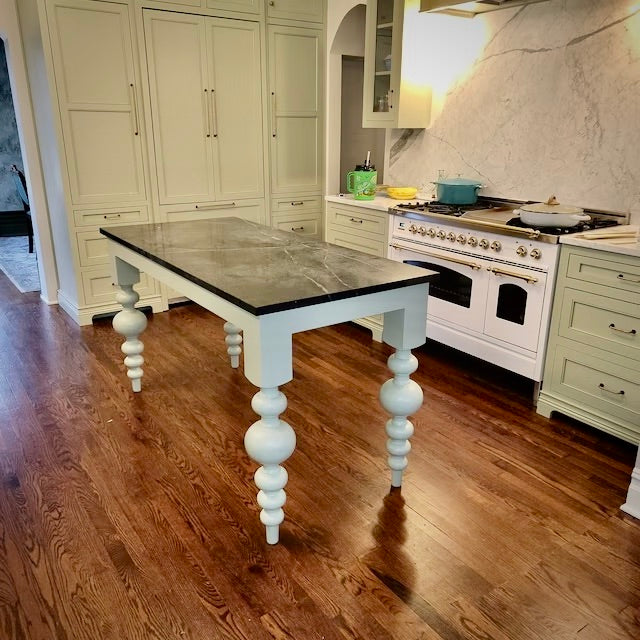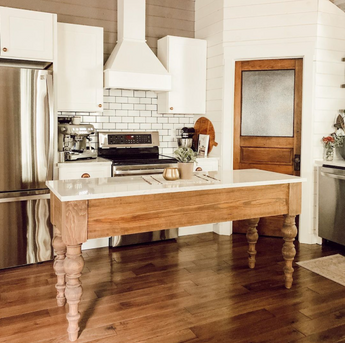Upgrade Your Kitchen with Stylish Kitchen Island Leg Solutions
Upgrade Your Kitchen with Stylish Kitchen Island Leg Solutions
Blog Article
The Significance of a Sturdy Cooking Area Island Leg in Developing a Functional Food Preparation Location
A strong cooking area island leg functions as a basic element in establishing a practical cooking environment, providing essential assistance for both the kitchen counter and different kitchen area activities. The stability it offers can considerably lower the threat of crashes in high-traffic locations, while also adding to the total visual comprehensibility of the room. As kitchen areas advance right into multifunctional areas for cooking, eating, and socializing, the option of materials and layout considerations for island legs ends up being progressively crucial. Comprehending these components can transform your kitchen right into a more secure and much more effective location, triggering more exploration into the most effective options readily available.
Advantages of Sturdy Island Legs
Providing crucial support, strong kitchen island legs play an essential duty in enhancing the capability and toughness of kitchen area islands - kitchen island leg. These legs not only birth the weight of the kitchen counter and any extra products positioned on the island, yet additionally add to the general security of the structure. A well-supported kitchen island guarantees that it remains functional and upright, even under hefty use, which is especially crucial in active cooking area atmospheres
In addition, durable island legs can improve the visual charm of the kitchen area. They supply a solid structure that can enhance different style styles, from contemporary to traditional. This adaptability enables homeowners to tailor their cooking area islands according to personal taste while making sure that the architectural honesty stays uncompromised.
Along with their encouraging role, durable kitchen island legs can additionally enhance security. A stable island reduces the threat of crashes brought on by tipping or tottering, which is especially vital in homes with kids or senior people. Strong legs can assist in a seamless flow of tasks, allowing for effective dish preparation and social interactions within the cooking area room. Eventually, buying sturdy kitchen island legs is important for a practical and aesthetically pleasing cooking location.
Products for Kitchen Island Legs
When selecting materials for cooking area island legs, resilience and aesthetic allure are essential variables to consider,. One of the most typical products consist of wood, metal, and crafted wood, each offering special benefits.
Wood, such as oak, maple, or cherry, is a traditional selection due to its strength and timeless appeal (kitchen island leg). It can withstand significant weight and is resistant to put on, making it ideal for high-use kitchen area environments. Furthermore, wood can be stained or painted to match numerous cooking area designs
Metal legs, frequently crafted from stainless steel or functioned iron, offer a commercial and modern-day appearance. They are incredibly solid and can support considerable loads while being immune to wetness and warm, which is beneficial in a cooking location. Metal legs can additionally be quickly cleaned up, boosting their functionality.

Style Factors To Consider for Stability
The selection of products for kitchen area island legs straight affects the style factors to consider for stability. When creating a cooking area island, it is vital to review the weight-bearing ability of the selected products. Larger materials, such as strong wood or metal, generally give better stability, specifically under the stress and anxiety of daily usage.
Furthermore, the leg style must integrate appropriate geometry to enhance stability. A larger base increases the assistance location, lessening the risk of wobbling or tipping. Consideration must likewise be given to the elevation of the legs; disproportionate leg lengths can bring additional reading about discrepancy, endangering the overall stability of the island.
Moreover, the distribution of weight throughout the island is essential. Making certain that the leg placement lines up with the heaviest elements, such as appliances and countertops, will further enhance stability.
Upkeep Tips for Longevity

Cleaning up is another crucial element of maintenance. Depending upon the material of the legs-- whether timber, steel, or composite-- proper cleansing methods ought to be used. For wooden legs, a gentle clean with a wet fabric and a suitable timber cleaner will certainly assist preserve their finish. Steel legs may require a light gloss to avoid rust and keep their radiance.
Furthermore, tightening up bolts and screws routinely can ensure security and stop wobbling. Take into consideration strengthening the legs with additional braces or sustains to enhance durability if the cooking area island experiences hefty use. Applying a safety finish or sealer can secure against dampness and spots, prolonging the lifespan of the legs. By complying with these maintenance suggestions, house owners can ensure their cooking area island legs continue to be robust and content practical for many years to come.
Choosing the Right Leg Design
Normal maintenance makes certain that kitchen island legs remain strong and functional, however selecting the appropriate leg style is similarly important for both aesthetics and assistance. The selection of leg style can considerably influence the general style and harmony of your kitchen.

Capability is one more critical aspect. Thicker legs or those with a strong base can support heavier counter tops and tools, boosting the island's utility. Conversely, slender legs may produce a ventilated appearance, suitable for lighter styles yet potentially less helpful.
Conclusion
In recap, the value of tough cooking area island legs can not be overstated in the production of a practical cooking area. These legs offer important assistance, boost security, and add to the general aesthetic of the cooking area.
A tough cooking area island leg offers as a basic element in establishing a practical cooking setting, offering needed support for both the kitchen counter and various kitchen tasks.Providing necessary support, durable kitchen island legs play a pivotal role in improving the functionality and longevity of cooking area islands. Eventually, spending in durable cooking area island legs is crucial for a practical and visually pleasing cooking location.
Consideration must additionally be given to the elevation of the legs; disproportionate leg sizes can lead to discrepancy, endangering the overall stability visit their website of the island.
Wooden legs provide warmth and a timeless look, while metal legs use a commercial and contemporary feeling.
Report this page